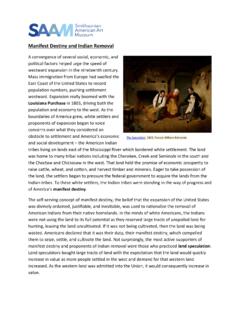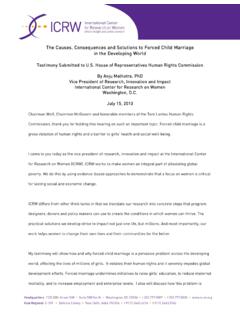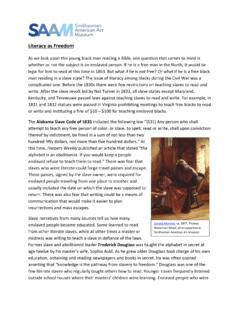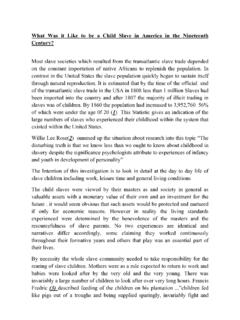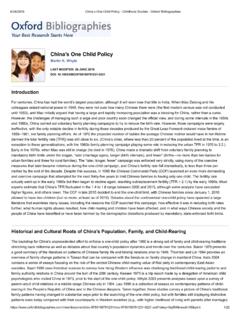Transcription of Econometrica, Vol. 78, No. 6 (November, 2010), 1863–1903
1 Econometrica, Vol. 78, No. 6 (November, 2010), 1863 1903 THE PERSISTENT EFFECTS OF PERU S MININGMITABYMELISSADELL1 This study utilizes regression discontinuity to examine the long-run impacts of themita, an extensive forced mining labor system in effect in Peru and Bolivia between1573 and 1812. Results indicate that amitaeffect lowers household consumption byaround 25% and increases the prevalence of stunted growth in children by around 6percentage points in subjected districts today. Using data from the Spanish Empire andPeruvian Republic to trace channels of institutional persistence, I show that themita sinfluence has persisted through its impacts on land tenure and public goods historically had fewer large landowners and lower educational , they are less integrated into road networks and their residents are substantiallymore likely to be subsistence.
2 forced labor, land tenure, public ROLE OF HISTORICAL INSTITUTIONSin explaining contemporary underde-velopment has generated significant debate in recent find quan-titative support for an impact of history on current economic outcomes (Nunn(2008), Glaeser and Shleifer(2002), Acemoglu, Johnson, and Robinson (2001,2002), Hall and Jones(1999)), but have not focused on channels of empirical evidence offers little guidance in distinguishing a variety ofpotential mechanisms, such as property rights enforcement, inequality, ethnicfractionalization, barriers to entry, and public goods. This paper uses variationin the assignment of an historical institution in Peru to identify land tenure andpublic goods as channels through which its effects , I examine the long-run impacts of the miningmita, a forcedlabor system instituted by the Spanish government in Peru and Bolivia in 1573and abolished in 1812.
3 Themitarequired over 200 indigenous communities tosend one-seventh of their adult male population to work in the Potos silver andHuancavelica mercury mines (Figure1). The contribution ofmitaconscriptschanged discretely at the boundary of the subjected region: on one side, allcommunities sent the same percentage of their population, while on the otherside, all communities were am grateful to Daron Acemoglu, Bob Allen, Josh Angrist, Abhijit Banerjee, JohnCoatsworth, David Cook, Knick Harley, Austin Huang, Nils Jacobsen, Alan Manning, Ben Olken,James Robinson, Peter Temin, Gary Urton, Heidi Williams, Jeff Williamson, and seminar partici-pants at City University of Hong Kong, Chinese University of Hong Kong, Harvard, MIT, Oxford,Stanford Institute of Theoretical Economics, and Warwick for helpful comments and also thank Javier Escobal and Jennifer Jaw for assistance in accessing data.
4 Research fundingwas provided by the George Webb Medley Fund (Oxford University).2 See, for example,Coatsworth(2005), Glaeser et al.(2004), Easterly and Levine(2003), Ace-moglu, Johnson, and Robinson (2001, 2002), Sachs(2001), andEngerman and Sokoloff(1997). 2010 The Econometric DELLFIGURE1. Themitaboundary is in black and the study boundary in light gray. Districts fallinginside the contiguous area formed by themitaboundary contributed to themita. Elevation isshown in the discrete change suggests a regression discontinuity (RD) approach forevaluating the long-term effects of themita, with themitaboundary forminga multidimensional discontinuity in longitude latitude space. Because valid-ity of the RD design requires all relevant factors besides treatment to varysmoothly at themitaboundary, I focus exclusively on the portion that transectsthe Andean range in southern Peru.
5 Much of the boundary tightly follows thesteep Andean precipice, and hence has elevation and the ethnic distribution ofthe population changing discretely at the boundary. In contrast, elevation, theethnic distribution, and other observables are statistically identical across thesegment of the boundary on which this study focuses. Moreover, specificationchecks using detailed census data on local tribute (tax) rates, the allocation oftribute revenue, and demography collected just prior to themita s institutionin 1573 do not find differences across this segment. The multidimensionalnature of the discontinuity raises interesting and important questions abouthow to specify the RD polynomial, which will be explored in the RD approach and household survey data, I estimate that a long-runmitaeffect lowers equivalent household consumption by around 25% inPERSISTENT EFFECTS OFMITA1865subjected districts today.
6 Although the household survey provides little powerfor estimating relatively flexible models, the magnitude of the estimatedmitaeffect is robust to a number of alternative specifications. Moreover, data froma national height census of school children provide robust evidence that themita s persistent impact increases childhood stunting by around 6 percent-age points in subjected districts today. These baseline results support the wellknown hypothesis that extractive historical institutions influence long-run eco-nomic prosperity (Acemoglu, Johnson, and Robinson(2002)). More gener-ally, they provide microeconomic evidence consistent with studies establishinga relationship between historical institutions and contemporary economic out-comes using aggregate data (Nunn(2008), Banerjee and Iyer(2005), Glaeserand Shleifer(2002)).
7 After examining contemporary living standards, I use data from the SpanishEmpire and Peruvian Republic, combined with the RD approach, to investi-gate channels of persistence. Although a number of channels may be relevant,to provide a parsimonious yet informative picture, I focus on three that thehistorical literature and fieldwork highlight as important. First, using district-level data collected in 1689, I document thathaciendas rural estates withan attached labor force developed primarily outside themitacatchment. Atthe time of themita s enactment, a landed elite had not yet formed. To min-imize the competition the state faced in accessing scarcemitalabor, colonialpolicy restricted the formation ofhaciendasinmitadistricts, promoting com-munal land tenure instead (Garrett(2005), Larson(1988)).
8 Themita s effectonhaciendaconcentration remained negative and significant in 1940. Second,econometric evidence indicates that amitaeffect lowered education histori-cally, and todaymitadistricts remain less integrated into road networks. Fi-nally, data from the most recent agricultural census provide evidence that along-runmitaimpact increases the prevalence of subsistence on the quantitative and historical evidence, I hypothesize that thelong-term presence of large landowners in non-mitadistricts provided a sta-ble land tenure system that encouraged public goods provision. The propertyrights of large landowners remained secure from the 17th century contrast, the Peruvian government abolished the communal land tenurethat had predominated inmitadistricts soon after themitaended, but didnot replace it with a system of enforceable peasant titling (Jacobsen(1993),Dancuart and Rodriguez(1902, Vol.))
9 2, p. 136)). As a result, extensive confisca-tion of peasant lands, numerous responding peasant rebellions as well as ban-ditry and livestock rustling were concentrated inmitadistricts during the late19th and 20th centuries (Jacobsen(1993), Bustamante Otero (1987, pp. 126 130),Flores Galindo(1987, p. 240), Ramos Zambrano (1984, pp. 29 34)). Be-cause established landowners in non-mitadistricts enjoyed more secure title totheir property, it is probable that they received higher returns from investingin public goods. Moreover, historical evidence indicates that well establishedlandowners possessed the political connections required to secure public goods1866 MELISSA DELL(Stein(1980)). For example, thehaciendaelite lobbied successfully for roads,obtaining government funds for engineering expertise and equipment, and or-ganizing labor provided by local citizens andhaciendapeons (Stein(1980,p.
10 59)). These roads remain and allow small-scale agricultural producers toaccess markets today, althoughhaciendaswere subdivided in the positive association between historicalhaciendasand contemporaryeconomic development contrasts with the well known hypothesis that histor-ically high land inequality is the fundamental cause of Latin America s poorlong-run growth performance (Engerman and Sokoloff(1997)). Engermanand Sokoloff argued that high historical inequalityloweredsubsequent invest-ments in public goods, leading to worse outcomes in areas of the Americasthat developed high land inequality during the colonial period. This theory simplicit counterfactual to large landowners is secure, enfranchised smallhold-ers of the sort that predominated in some parts of North America.










